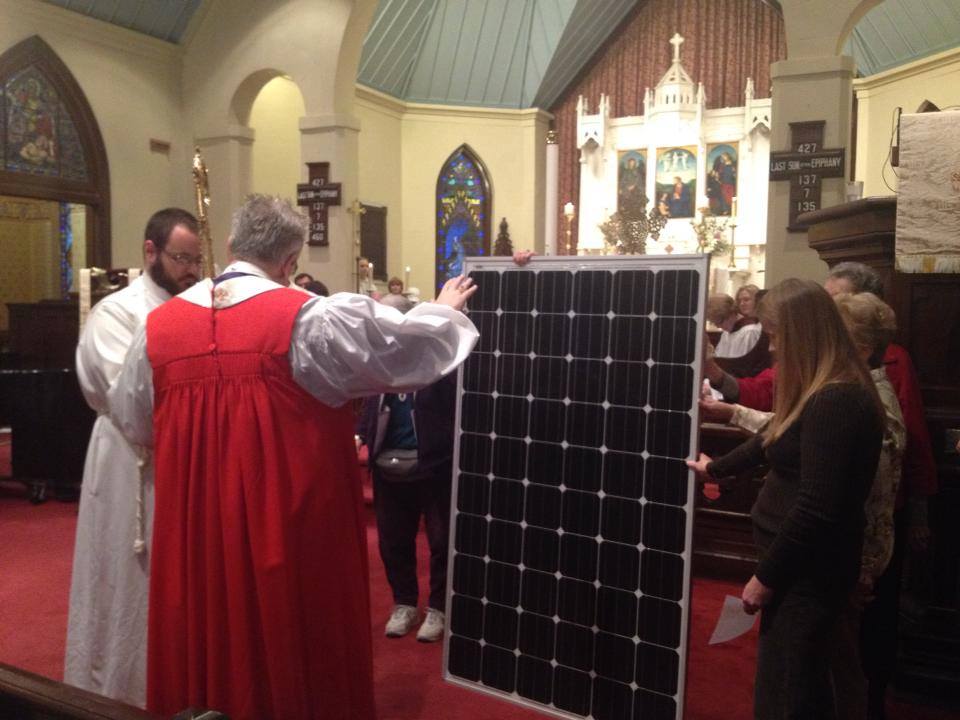This commentary originally appeared on our Texas Clean Air Matters blog.
On Monday in the heart of downtown Austin, St. David’s Episcopal Church unveiled its new 146-kilowatt solar array. Covering the rooftop of an adjacent parking garage and earning the title of largest rooftop solar installation downtown.
The project’s unprecedented scale was made possible through a partnership with Meridian Solar and a new Austin Energy (AE) pilot program, testing how they can best integrate large rooftop solar with the utility’s grid. Church members had the idea to put solar panels on the parking garage ten years ago, but weren’t able to move forward until last year when low interest rates, improved technology, and government rebates all came together. Through their combined efforts, St. David’s, AE, and Meridian have taken a vital, first step towards a city powered by clean, local, rooftop power, also known as distributed generation (DG).
Austin embraces distributed generation
Austin Energy’s multi-year collaboration with St. David’s is an admirable sign of progress in an era that often pits utilities against rooftop solar advocates. The cost of solar panels has dropped 80 percent since 2008, including 20 percent in 2012 alone. The rapid drop in price has unleashed renewed demand: installed rooftop solar energy increased 900 percent between 2000 and 2011. Some U.S. electric utilities see this growth as a threat to their business model, prompting them to cut back on incentives for solar power. Austin Energy, on the other hand, is part of a growing community of utilities embracing distributed generation as a vital part of their transition to carbon-free, renewable energy and enhancing their business models to meet this challenge.
Austin Energy offers a unique incentive for rooftop solar generation. Rather than simply roll back customers’ bills or pay for solar electricity at wholesale energy prices, Austin pays customers a “value of solar tariff,” which is calculated based on expected fuel savings, offset power plant construction, transmission and distribution savings, and environmental benefits. By considering each of these pieces in valuing solar energy, Austin Energy comes up with a value measure of 14 cents per kilowatt-hour of solar energy paid to those generating the solar.
For churches and other places of worship, rooftop solar and other demand-side energy solutions can allow churches to spend money on their goodwill instead. St. David’s will be paid a solar tariff for all the solar electricity its system produces over its lifetime, diverting over $500,000 that would have been spent on energy to vital programs like the church’s homeless shelter. To commemorate this success, during this Sunday’s service, Bishop C. Andrew Doyle blessed the panels, followed by the congregation singing “This Little Light of Mine.”
Overcoming infrastructure barriers was key to success
Financing is only one half of what enabled a downtown project of this scale. For years, the design of AE’s downtown distribution system limited the size of rooftop solar to a maximum of 20 kilowatts—less than one seventh the size of St. David’s array. Austin Energy worked closely with the project developer, Meridian Solar, to engineer and calibrate the AC-DC inverters connecting the solar panels to the grid so that the system produces the maximum amount of energy without disrupting the local power grid.
By working together, this collaboration unlocked the financing and technical know-how required to install 146 kilowatts of solar energy on an already crowded downtown grid, thereby reducing the church’s bill and providing Austin Energy with a valuable source of clean energy located at the center of its electricity demand hub, downtown Austin. St. David’s can now use its solar energy to help power the rock shows they host during SXSW in a few weeks.
Unique partnership shines as a model for future solar projects
Austin continues to be a model for the municipal utility of the 21st century. Already, other cities are contacting AE to figure out how to replicate this project in their own locales. Even deregulated utilities are making progress, exemplified by NRG’s Friday announcement that they will begin offering rooftop solar to 2.3 million customers over the next few years. But, according to State Impact Texas, “[Austin Energy] urges patience. It will take at least a couple years of monitoring Saint David’s solar power installation before the city has a clear sense of how well the system works from a technical and economic standpoint.”
It’s encouraging to see these three entities working together to create a clean energy solution whose success is predicated on their unique private, public, religious partnership. This exciting project is a needed boost in the Austin solar world, as last week local solar-film company HelioVolt announced that, after losing a round of venture funding, they would be suspending manufacturing operations and laying off employees. This highlights that Texas policymakers, at every level, must make solar energy a priority. Breaking down the obstacles that have prevented projects from proceeding smoothly will lead to market stability. Given Texas has the highest potential for solar of any state in the US, yet is currently ranked behind Delaware in output, investors should be flocking to the state in droves, not pulling out.










